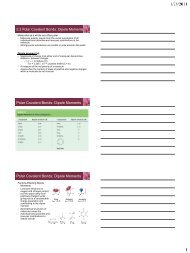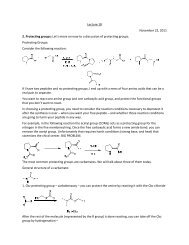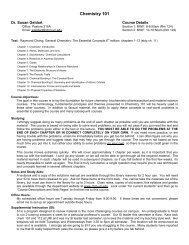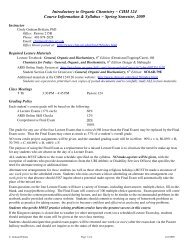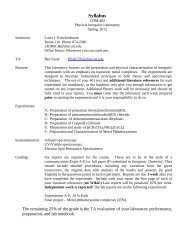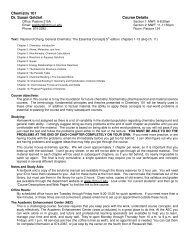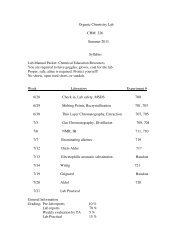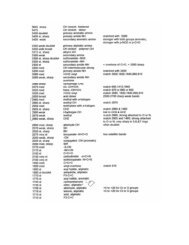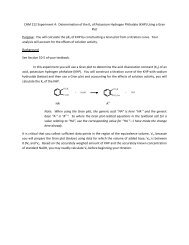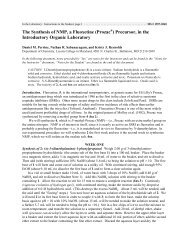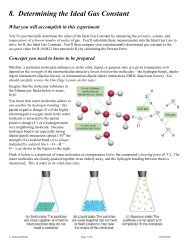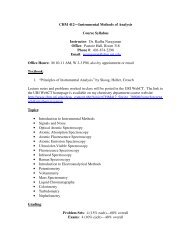If it’s not, you’ll need to think back through the various steps <strong>of</strong> the procedure, identify the possible sources <strong>of</strong>experimental error, and consider how each source <strong>of</strong> error might have contributed to making your experimentalresult too high or too low.You can see that it’s essential to do a good job <strong>of</strong> recording your data and observations, so that you’ll be able tomake a thorough assessment as to why your experimental result is higher or lower than the true value.Procedure that you will follow1. Measure a known mass <strong>of</strong> copper (II) chloride into a 250-mL beaker (approximately 3 grams, but weighed tothe maximum number <strong>of</strong> significant figures provided by the balance).2. Add approximately 60 mL <strong>of</strong> distilled water to the beaker and stir until the copper (II) chloride has completelydissolved. The resulting solution should be the brilliant blue color that is characteristic <strong>of</strong> Cu 2+ ions in aqueoussolution.3. Your lab instructor will provide you with an aluminum wire and demonstrate how to shape it into a coil. Takea moment to measure the initial mass <strong>of</strong> the wire. You’ll then immerse the coiled end <strong>of</strong> the wire in the coppersolution. Maintain your grasp on the other end <strong>of</strong> the rod, so that you can use it to stir the reaction mixture.4. Watch closely to observe the chemical reaction that occurs, and make detailed notes <strong>of</strong> your observations inyour lab notebook.IMPORTANT: Be sure to review the Skills in Recording Observations provided in the Remedies document:When recording observations <strong>of</strong> a substance, describe everything that you see (or perhaps smell): Is thesubstance a solid, liquid, or gas? Is it a solution? What color is it? Is it opaque, translucent, or transparent? Ifyou are instructed to waft the vapors toward your nose, does the substance have an odor?When recording observations <strong>of</strong> a reaction, first write down what you did (heat a solution, or add one chemicalto another and mix thoroughly). Then write down what you saw, heard, smelled, or felt with your fingertips:Was there a color change? Did a gas evolve? Did a solid form? Was an odor emitted? Was there any sound?Was any heat evolved? (If yes, monitor the temperature change with your thermometer, and record it as anobservation.) How long did it take for the reaction to occur?A Note on Common Sense and Experimental Technique:Because the chemical reaction between the Cu 2+ ions and the Al atoms is taking place on the surface <strong>of</strong> thealuminum wire, the copper metal that’s produced by the reaction will accumulate on that surface. So you’llneed to use your metal spatula or glass stirring rod to scrape or knock the copper metal <strong>of</strong>f the wire as thereaction progresses. The goal is to keep exposing the aluminum surface to the solution so that the reaction cancontinue all the way to completion (until all <strong>of</strong> the copper ions in the solution have been converted to coppermetal).5. When the reaction appears to be complete, remove the aluminum wire, rinse and dry it thoroughly, determineits final mass, and then return it to your lab instructor.6. Now you’ll need to separate the copper metal from the reaction mixture by vacuum filtration. In preparationfor this procedure, pre-weigh a piece <strong>of</strong> filter paper (that fits in the Buchner funnel) with your watchglass. Setup the vacuum filtration apparatus as illustrated in the LabCam video and described in the Remedies document.Be sure to follow the steps carefully – especially securing the Buchner funnel to the filter flask with the rubberadaptor, and clamping the neck <strong>of</strong> the filter flask to a ring stand. Ask your lab instructor to inspect yourvacuum filtration set-up before you begin filtration.7. As shown in the video, you’ll need to place your pre-weighed filter paper in the Buchner funnel, pre-moisten itwith water, and make certain that the wet paper forms a seal against the funnel when the vacuum is turned on.C. Graham Brittain Page 4 <strong>of</strong> 9 9/28/2010
Then pour the mixture into the center <strong>of</strong> the funnel. Remember that you can use small squirts <strong>of</strong> distilled waterfrom your plastic wash bottle to rinse the copper from the beaker into the funnel.8. As the final step to the vacuum filtration, rinse the copper metal in the funnel with several squirts <strong>of</strong> acetonefrom the plastic squeeze bottle provided in the hood. Acetone is a volatile organic solvent, so it will help thecopper dry more quickly. You should also allow the vacuum to pull air through the copper for several minutes,to remove excess liquid and hasten drying.9. Then carefully transfer the wet filter paper and copper metal from the funnel to the pre-weighed watch lass. Besure to spread the copper across the surface <strong>of</strong> the watchglass to enable its drying. Mark the watchglass withyour initials, and then place it in the heated oven to dry. When the drying and cooling is complete, weigh andrecord the mass <strong>of</strong> the watchglass (containing the dried filter paper and copper). The mass <strong>of</strong> the copper metalcan be determined by difference.10. Then by difference, determine the mass <strong>of</strong> chlorine in your original sample <strong>of</strong> copper (II) chloride.11. Use Atomic Weights from the Periodic Table to convert your masses <strong>of</strong> copper and chlorine to moles, thendetermine your experimental mole ratio <strong>of</strong> chlorine to copper.IMPORTANT: You MUST dispose <strong>of</strong> all chemical waste as directed by your lab instructor. Do NOT put anychemical waste in the laboratory sinks or garbage cans. Use the solid and liquid waste containers in the hood asdirected by your lab instructor.ALSO IMPORTANT: Please thoroughly clean your laboratory glassware before replacing it in your equipmentdrawer. Large Nalgene bottles <strong>of</strong> soap solution are provided near the laboratory sinks. You should notify your labinstructor if the stock <strong>of</strong> soap solution is running low.C. Graham Brittain Page 5 <strong>of</strong> 9 9/28/2010



